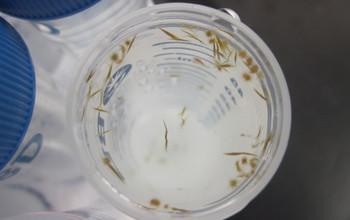Revealing the ocean's hidden fertilizer

Tiny marine plankton form colonies in a variety of shapes visible to the naked eye. Credit: Carly Buchwald, WHOI
An essential nutrient for every living organism–humans require approximately 700 milligrams per day–we're rarely concerned about consuming enough because it is in most of the foods we eat.
Despite its ubiquity and living organisms' dependence on it, we know surprisingly little about how it moves, or cycles, through the ocean environment.
Scientists studying the marine phosphorous cycle have known that phosphorus was absorbed by plants and animals and released back to seawater in the form of phosphate as these plants and animals decay and die.
But a growing body of research hints that microbes in the ocean transform phosphorus in ways that remain a mystery.
Hidden role of ocean's microbes
A new study by a research team from the Woods Hole Oceanographic Institution (WHOI) and Columbia University reveals for the first time a marine phosphorus cycle that is much more complex than previously thought.
The work also highlights the important but previously hidden role that some microbial communities play in using and breaking down forms of this essential element.
A paper reporting the findings is published this week in the journal Science.
“A reason to be excited about this elegant study is in the paper's last sentence: 'the environmental, ecological and evolutionary controls …remain completely unknown,'” says Don Rice, program director in the National Science Foundation's (NSF) Division of Ocean Sciences, which funded the research through its Chemical Oceanography Program. “There's still a lot we don't know about the sea.”
The work is also supported by an NSF Dimensions of Biodiversity grant.
“This is an exciting new discovery that closes a fundamental knowledge gap in our understanding of the marine phosphorus cycle,” says the paper's lead author Ben Van Mooy, a biochemist at WHOI.
Much like phosphorus-based fertilizers boost the growth of plants on land, phosphorus in the ocean promotes the production of microbes and tiny marine plants called phytoplankton, which compose the base of the marine food chain.
Phosphonate mystery
It's been unclear exactly how phytoplankton are using the most abundant forms of phosphorus found in the ocean–phosphates and a strange form of phosphorus called phosphonates.
“Phosphonates have always been a huge mystery,” Van Mooy says.
“No one's been able to figure out exactly what they are, and more importantly, if they're made and consumed quickly by microbes, or if they're just lying around in the ocean.”
To find out more about phosphonates and how microbes metabolize them, the researchers took samples of seawater at a series of stations during a research cruise from Bermuda to Barbados.
They added phosphate to the samples so they could see the microbes in action.
The research team used ion chromatography onboard ship for water chemistry analyses, which allowed the scientists to observe how quickly microbes reacted to the added phosphate in the seawater.
“The ion chromatograph [IC] separates out the different families of molecules,” explains Van Mooy.
“We added radioactive phosphate, then isolated the phosphonate to see if the samples became radioactive, too. It's the radioactive technique that let us see how fast phosphate was transformed to phosphonate.”
Enter the microbes
The researchers found that about 5 percent of the phosphate in the shallow water samples was taken up by the microbes and changed to phosphonates.
In deeper water samples, which were taken at depths of 40 and 150 meters (131 feet and 492 feet), about 15 to 20 percent of the phosphates became phosphonates.
“Although evidence of the cycling of phosphonates has been mounting for nearly a decade, these results show for the first time that microbes are producing phosphonates in the ocean, and that it is happening very quickly,” says paper co-author Sonya Dyhrman of Columbia University.
“An exciting aspect of this study was the application of the IC method at sea. In near-real-time, we could tell that the phosphate we added was being transformed to phosphonate.”
Better understanding of phosphorus cycle
A better understanding of phosphorus cycling in the oceans is important, as it affects the marine food web and, therefore, the ability of the oceans to absorb atmospheric carbon dioxide.
The researchers say that solving the mystery of phosphonates also reinforces the need to identify the full suite of phosphorus biochemicals being produced and metabolized by marine microbes, and what physiological roles they serve for these cells.
“Such work will help us further resolve the complexities of how this critical element is cycled in the ocean,” Dyhrman adds.
###
Grants from the Simons Foundation also supported the work.
Media Contact
All latest news from the category: Earth Sciences
Earth Sciences (also referred to as Geosciences), which deals with basic issues surrounding our planet, plays a vital role in the area of energy and raw materials supply.
Earth Sciences comprises subjects such as geology, geography, geological informatics, paleontology, mineralogy, petrography, crystallography, geophysics, geodesy, glaciology, cartography, photogrammetry, meteorology and seismology, early-warning systems, earthquake research and polar research.
Newest articles

NASA: Mystery of life’s handedness deepens
The mystery of why life uses molecules with specific orientations has deepened with a NASA-funded discovery that RNA — a key molecule thought to have potentially held the instructions for…

What are the effects of historic lithium mining on water quality?
Study reveals low levels of common contaminants but high levels of other elements in waters associated with an abandoned lithium mine. Lithium ore and mining waste from a historic lithium…

Quantum-inspired design boosts efficiency of heat-to-electricity conversion
Rice engineers take unconventional route to improving thermophotovoltaic systems. Researchers at Rice University have found a new way to improve a key element of thermophotovoltaic (TPV) systems, which convert heat…



